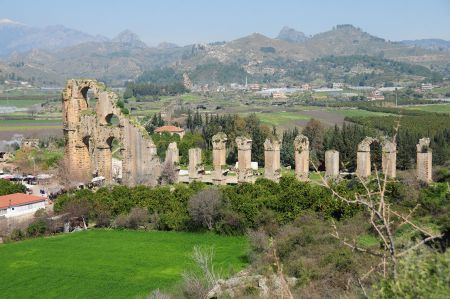Water supply in the Roman Empire
- Written by Portal Editor
The quality of execution in the Roman Empire is absolutely comparable to the technology of road construction and in some cases very cleverly combined with road construction is the construction of the water supply systems in the cities of the empire.
The Romans knew very well how to distinguish the problems in planning the water supply and disposal of an already existing city from those of a new city that was to be founded. Every time a new company was founded, the supply of fresh water and the disposal of wastewater were first considered before the final location of a city was decided. Planned urban development was standard for centuries and then was almost completely forgotten again for more than 1,000 years. If we look around a little, even today, despite the most modern technology, we are often not able to sensibly coordinate planning and execution. There are enough examples.
Bridging large height differences in the terrain
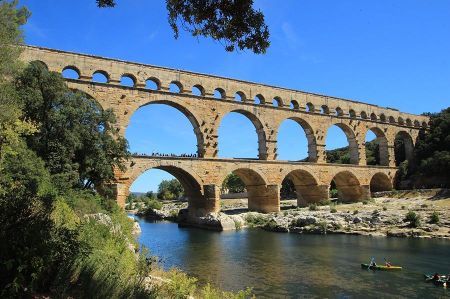 On the other hand, you stand in front of the Pont du Gard near Nimes in southern France full of respect and admiration and are amazed at how such a monumental water supply structure was first built in combination with a road and secondly how it could survive 2,000 years.
On the other hand, you stand in front of the Pont du Gard near Nimes in southern France full of respect and admiration and are amazed at how such a monumental water supply structure was first built in combination with a road and secondly how it could survive 2,000 years.
The Pont du Gard is just one of many well-preserved Roman water supply buildings. Let's take the aqueduct near Segovia in central Spain, which was built under Emperor Trajan between 98 and 117 AD and is still considered a masterpiece of Roman engineering and brought water to Segovia from 15 kilometres away. Interested visitors should also take a close look at the aqueduct in Aspendos / Turkey.
How could the Romans, without modern technology, build pressurized water pipes that could bridge large differences in height in the terrain, so that a constant flow of water was still guaranteed. But let's start at the source.
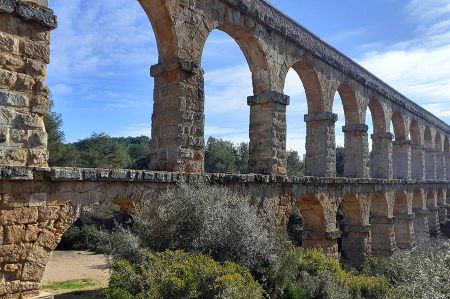 Rome's city planners were well aware that it was often easier to create a city from scratch than to integrate water systems into existing cities. The question of location was always considered against the background of existing water sources. Once they discovered a rich source, the Romans did not shy away from long transport routes for water.
Rome's city planners were well aware that it was often easier to create a city from scratch than to integrate water systems into existing cities. The question of location was always considered against the background of existing water sources. Once they discovered a rich source, the Romans did not shy away from long transport routes for water.
Vitruvius describes finding sources in his book “de architectura”: “Before sunrise, lie with your face on the ground and prop your chin up and look at the surroundings […] if you see moist vapors curling up and rising in the air, you should you dig there.”
The source of supply is approximately 27 kilometers away
A very good example is the water supply in the city of Side / Türkiye. The source of supply is about 27 kilometres away, where the Oymapinar Dam now stores the water of the Manavgat River.
Initially guided in channels carved into the rock, the water's path leads through tunnels and over viaducts, with only a 35-meter difference in height available to maintain the water flow over a length of 27 kilometres. A structural engineering masterpiece without satellite navigation over mountains and partial cuts.
In Perge near Antalya there is a special feature because here the water pipe was elevated in the median area of the road through the city. Large parts of it are still preserved and waiting for you.
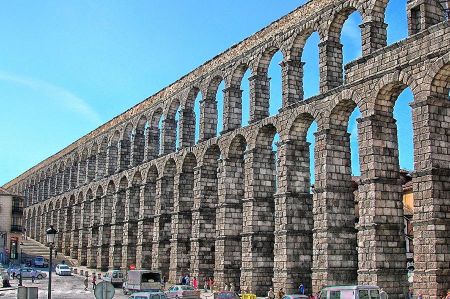 At the source, the so-called spring house was usually built from water-permeable walls, which served to contain the source, protect it from pollution and was sometimes used to filter out components from the water. Depending on the local conditions, the water then flowed from the spring house through natural rock channels, through dug tunnels or over built bridges to the city. Since the flow speed decreased with distance depending on the thickness of the source, there were also rules regarding the gradient of the pipe systems.
At the source, the so-called spring house was usually built from water-permeable walls, which served to contain the source, protect it from pollution and was sometimes used to filter out components from the water. Depending on the local conditions, the water then flowed from the spring house through natural rock channels, through dug tunnels or over built bridges to the city. Since the flow speed decreased with distance depending on the thickness of the source, there were also rules regarding the gradient of the pipe systems.
A slight gradient had to be built in at all times, which the planner and architect Vitruvius usually describes as 0.5%, but at the Pont du Gard it was only 0.035%, which corresponds to a gradient of 35 centimetres per 1 kilometre. These different types of pipe systems were usually based on so-called gravity pipes, which were only covered to protect against pollution or excessive evaporation in summer or to protect against freezing over in winter. This meant that the water remained pleasantly cool even in summer.
Bridges were built to overcome valleys
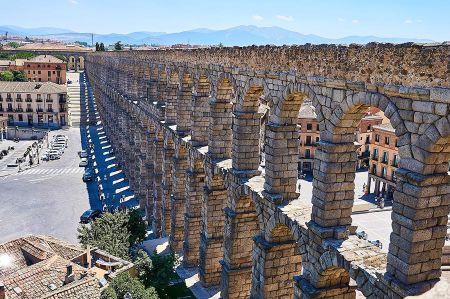 Especially when tunnels had to be passed through, control and ventilation shafts were installed to the water channel so that fresh air/oxygen was constantly supplied to the water. In order to “turn” the water in the canal, structures were built into the rock so that enrichment with oxygen was easier. When crossing valleys, bridges (aqueducts or viaducts), sometimes over several floors, were built, which could contain several watercourses one above the other or were used to convey water and the course of the road at the same time.
Especially when tunnels had to be passed through, control and ventilation shafts were installed to the water channel so that fresh air/oxygen was constantly supplied to the water. In order to “turn” the water in the canal, structures were built into the rock so that enrichment with oxygen was easier. When crossing valleys, bridges (aqueducts or viaducts), sometimes over several floors, were built, which could contain several watercourses one above the other or were used to convey water and the course of the road at the same time.
Depending on the amount of water to be absorbed, the canals were between 50 centimetres and 2 meters wide and were often covered on the inside with waterproof plaster (opus signinum).
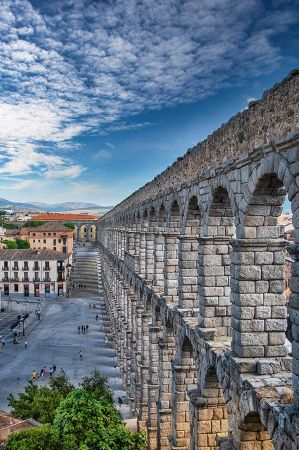 To overcome valleys, pressure pipe systems were built that worked on the basic physical principle of communicating tubes (siphon system). This can be seen very impressively in Aspendos, where there is a water tower on one side of the valley, then the pressure pipe is laid through the valley and the second water tower follows on the other side of the valley, in which the water rises again to the distribution station for Aspendos.
To overcome valleys, pressure pipe systems were built that worked on the basic physical principle of communicating tubes (siphon system). This can be seen very impressively in Aspendos, where there is a water tower on one side of the valley, then the pressure pipe is laid through the valley and the second water tower follows on the other side of the valley, in which the water rises again to the distribution station for Aspendos.
The usual clay pipes were not able to handle the water pressure alone, so massive pipes made of rock were used for these pressure pipes, which still fit together precisely via cone seals and thus minimized the loss.
Pressure pipes made of clay or lead
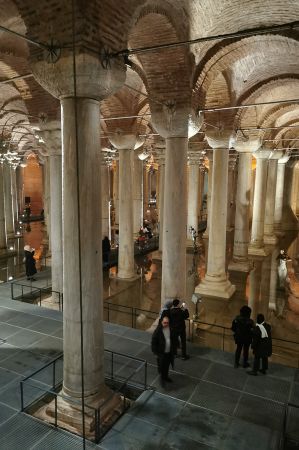 Once the aqueduct reached the city's highest point, a distribution station (castellum) was built, which is similar to a modern water tower and was often referred to as the “Wasserschlösschen”. There were usually three main branches branching off from the castellum, which were often also built into the castellum at different heights, so that the water flow could automatically be brought to the most important supply points such as the public drinking water fountains. The second highest position usually went to public baths and the highest position to the private homes of the rich. If there was a shortage of drinking water, at least the public drinking water places were supplied with fresh water for the longest time.
Once the aqueduct reached the city's highest point, a distribution station (castellum) was built, which is similar to a modern water tower and was often referred to as the “Wasserschlösschen”. There were usually three main branches branching off from the castellum, which were often also built into the castellum at different heights, so that the water flow could automatically be brought to the most important supply points such as the public drinking water fountains. The second highest position usually went to public baths and the highest position to the private homes of the rich. If there was a shortage of drinking water, at least the public drinking water places were supplied with fresh water for the longest time.
In cities, the pipe systems were usually designed as pressure pipes made of clay or lead. If the distance to the castellum became too great, a new castellum was inserted between them. The lead pipes were manufactured almost industrially; lead plates were cast and bent into pipes. The seam was then soldered so that the pipes often had a pear-shaped cross-section rather than being round.
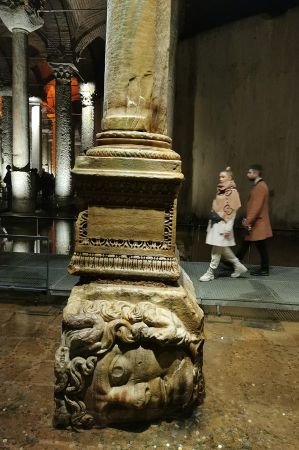 Huge amounts of lead were required to manufacture the pipes; it was found that around a ton of lead was required for a 10-centimetre-thick pipe that was 37 meters long. Although Vitruvius repeatedly warned of the negative consequences for humans when using lead pipes due to metallic poisoning, lead was the main material used. Despite this 2,000-year-old knowledge, lead was also used in Europe well into the 19th century. Progress? The materials wood, leather and stone were also sometimes used in pipeline construction.
Huge amounts of lead were required to manufacture the pipes; it was found that around a ton of lead was required for a 10-centimetre-thick pipe that was 37 meters long. Although Vitruvius repeatedly warned of the negative consequences for humans when using lead pipes due to metallic poisoning, lead was the main material used. Despite this 2,000-year-old knowledge, lead was also used in Europe well into the 19th century. Progress? The materials wood, leather and stone were also sometimes used in pipeline construction.
In cities with a large water requirement, additional cisterns were usually set up to temporarily store the water. The Fildami Cistern near Istanbul is very well known and was able to temporarily store around 100,000 cubic meters of water. Also known in Istanbul is the cistern known as the “Sunken Palace”, which has a supporting structure made from the remains of Corinthian columns and is worth seeing for that reason alone.
Please read as well:
